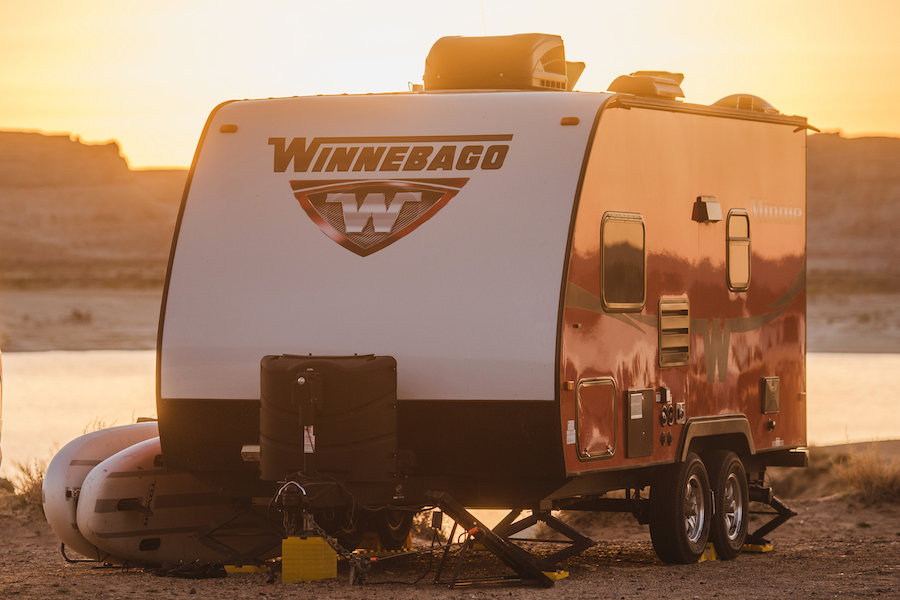By Eric Smith
Winnebago Industries Inc. CEO Mike Happe admits the recreational vehicle industry is facing some challenging wholesale headwinds, but he also believes the marketplace—and especially his company—is resilient enough to weather them.
According to the RV Industry Association’s February survey of manufacturers, total RV shipments ended the month with 36,421 wholesale shipments, down 15.4 percent from the 43,038 units shipped in February 2018. Wholesale shipments are projected to decrease in the mid-single digits this year.
Speaking on Monday morning’s earnings call after Winnebago reported fiscal second-quarter earnings, Happe cited the RVIA’s most recent report as well as its wholesale forecast for 2019, but he also noted that the company has managed take market share amid overall softness.
“Wholesale market conditions, especially in our RV segments are even tougher than we had originally planned,” Happe said. “But we are gaining material consolidated retail and shipment market share as a company. As we move into the second half of the year, we will look to build on the momentum we created through all of our business segments. We are committed to driving higher levels of profitability and asset utilization, delivering sales results that continue to outpace the industries we serve and pursuing new growth opportunities that position Winnebago Industries and its brands for future success.”
Winnebago’s revenues for the Fiscal 2019 second quarter ended February 23 were $432.7 million, a decrease of 7.6 percent compared to $468.4 million for the Fiscal 2018 period.
Net income for the Fiscal 2019 second quarter was $21.6 million, a decrease of 2.2 percent compared to $22.1 million in the same period last year. Earnings per diluted share were 68 cents, a decrease of 1.4 percent compared to earnings per diluted share of 69 cents in the same period of 2018.
Net Income and earnings per share were favorably impacted by discrete tax items totaling $2.5 million, or 8 cents. Consolidated adjusted EBITDA for the quarter was $34.5 million, compared to $39.4 million last year, a decrease of 12.4 percent.
Both of Winnebago’s two main segments—motorhomes and towables—suffered revenue declines with the biggest drops coming in motorhomes.
Q2 revenues for the motorhome segment were $164.7 million, down 17.3 percent from the prior year driven primarily by a decrease in Class A and Class C unit sales, partially offset by an increase in Class B unit sales. Backlog decreased 38.6 percent, in dollars, versus the prior year, reflecting dealers continuing to right-size inventory levels and prior year Class B new product order timing.
Q2 revenues for the towable segment were $250.7 million, down 5.9 percent from the prior year, driven by dealer network efforts to reduce inventory levels and comparing against very strong shipments in the prior year, partially offset by pricing. Backlog levels remained strong at over 8,000 units but declined 5.7 percent, in dollars, versus the prior year, reflecting the positive impact of utilizing additional capacity added during calendar 2018 and dealers continuing to right-size inventory levels.
Happe said Winnebago’s focus for the remainder of 2019 is continuing to invest in talent and “creating a more efficient organization operationally.”
While the company is, of course, looking to create shareholder value each quarter, Winnebago has its sights set on “creating a long-term business model with a high-performance engine for profitable growth in the years ahead. And as a more diversified company focusing on quality, innovation, and service, we will continue to make solid progress towards our goal of transforming Winnebago Industries into a premier outdoor lifestyle company.”
That emphasis on “outdoor lifestyle company” is something Happe expanded on in his comments Monday morning and it’s one reason the company remains optimistic amid less-than-enthusiastic market projections.
“Although sentiment in the broader RV market has maintained its bearish trajectory, we remain optimistic about the long-term retail prospects for the RV industry,” Happe said. “Secular demand for camping, being outdoors and generally collecting experiences versus possessions is continuing to grow across multiple lifestyle and demographic segments. The versatility and breadth of what is called a recreational vehicle continue to expand and brings more and more interest to the space.
“In the short term, there remains a good deal of macroeconomic noise as it relates to the RV industry. Recent industry reports clearly show a decline in RV shipments in the first part of 2019 due to dealer inventory rationalization, following unusually high seasonal orders in the previous year and retail that has slowed from years of double-digit compound growth.”
Playing in the outdoor space is something industry stakeholders spoke of in SGB Media’s recent look at the RV market, RV Industry Convenes As Market Continues To Accelerate. As RV dealers attract core outdoor enthusiasts, who in turn look to motorhomes, towables and sprinter vans to access their favorite activities, both industries will benefit.
But Winnebago is banking on its core business to also help withstand headwinds. The company believes it has the right product mix—from motorhomes to towables to the “strategically important benefits from our new Marine play in Chris-Craft,” Happe said—to thrive amid the industry slowdown.
“At Winnebago Industries, we remain steadfast in the pursuit of our vision around becoming a trusted outdoor lifestyle, our internal transformation efforts around talent, process, portfolio, and capital allocation have not only advanced our competitive position in the industry but they have also made our company more resilient, hopefully more consistent and able to better navigate the headwinds affecting the RV industry without surprising or dire consequences,” he said.
Photo courtesy Winnebago Industries Inc.
[author] [author_image timthumb=’on’]https://s.gravatar.com/avatar/dec6c8d990a5a173d9ae43e334e44145?s=80[/author_image] [author_info]Eric Smith is Senior Business Editor at SGB Media. Reach him at eric@sgbonline.com or 303-578-7008. Follow on Twitter or connect on LinkedIn.[/author_info] [/author]
















